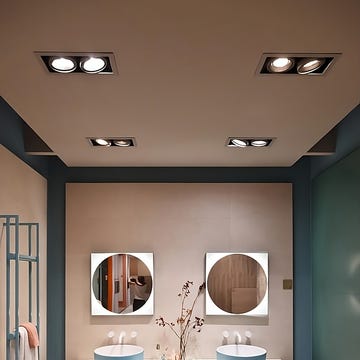The Factory House, designed by Inez Kuiper, is a quiet bolthole built on the site of a former gunpowder factory in Muiden. Sitting on the bank of a natural lake, it is surrounded by forest, with the sea just a stone’s throw away.
Daylight pours into the house from every angle, through generous floor-to-ceiling glazing complemented by VELUX roof windows, placed rhythmically to heighten the architectural impact of the space.
The home is a case study in the art of welcoming in natural light, a topic ELLE Decoration discussed with an assembled group of experts including London-based designers Miminat Shodeinde and Hollie Bowden, Italian designer and art director Tommaso Spinzi, and German architect Katharina Buseinus.
Bowden, who specialises in creating bright, airy spaces filled with art and character, explained how daylight plays a crucial part in her work.
‘As interior designers, we’re always trying to maximise the best features of a space,’ she said. ‘Natural light is incredibly important, it can completely transform a space.’
Shodeinde, the founder of Miminat Designs, agreed, noting how the roof windows at The Factory House were ‘a very interesting and dynamic way to introduce natural light in a space’.
‘Daylight, for me, is absolutely everything,’ she added. ‘I think it’s the most important aspect of any space, any room.’
The benefits of natural light are manifestly clear, with countless studies demonstrating just how essential daylight light is to a healthy lifestyle – it can transform our mood and improve energy levels, concentration, creativity and sleep patterns.
There are also tangible mental health benefits – a review published in December 2021 concluded that each additional hour spent in natural light was linked to a corresponding decrease in the risk of developing long-term depression.
At the Factory House, the ever-evolving interplays of natural light and shadow created by the roof windows complement the design scheme. In the daytime, the black steel staircase is illuminated by shimmers of sunlight, which bounce across concrete and timber floors and soft furnishings.
As Buseinus, the Hamburg-based architect, noted: ‘Natural light makes a room more aesthetic, spacious and inviting.’
But the advantages of VELUX roof windows go far beyond that. They provide a constant connection with nature (Buseinus, for one, loves falling asleep underneath the stars) which in turn inspires moments of reverie. They also ensure a healthier indoor environment with cleaner air thanks to the ‘stack effect’, whereby stale air is drawn out through the roof windows and replaced by fresh air entering on the lower floors.
At the Factory House, the roof windows are opened and closed remotely via the VELUX Active app, which also allows for their anti-heat blackout shutters to be drawn — an essential function as spring starts to turn into summer. Made from aluminium, they can reduce indoor temperatures by up to five degrees, contributing to a more comfortable atmosphere.
At the end of their visit, the group reflected on the energising feeling created in the house.
‘Daylight influences my mood a lot, especially during springtime when the days are warming up,’ said Spinzi.
Shodeinde added: ‘I just think it just puts you in a better mood, and makes you a happier, more productive person.’
Visit VELUX.co.uk for more.


















